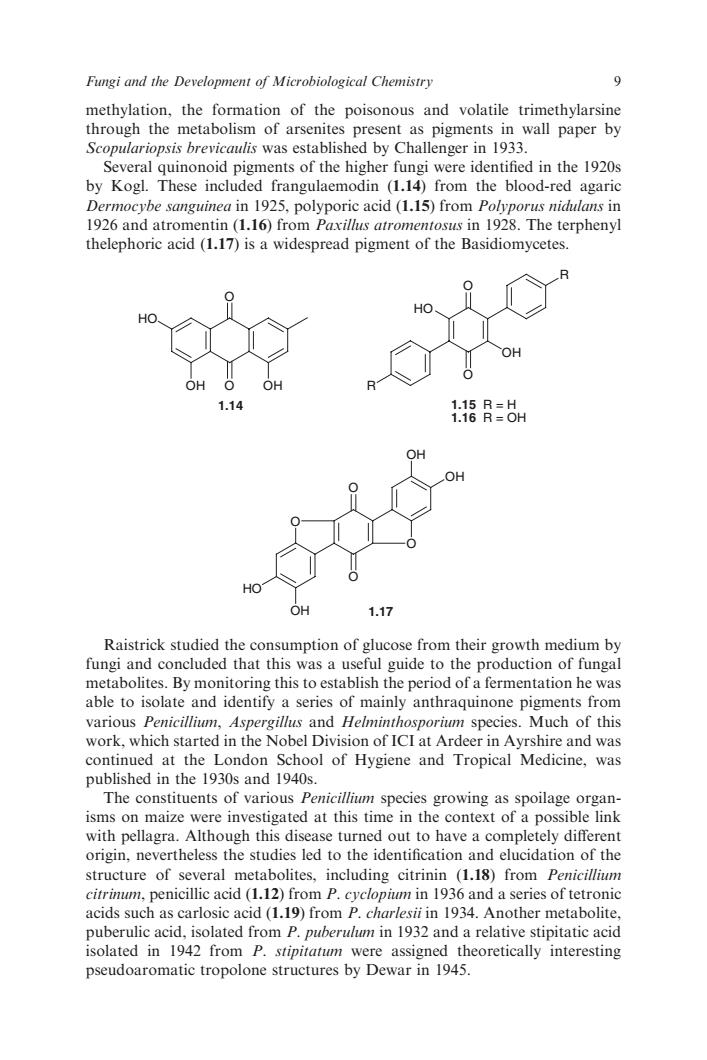正在加载图片...

Fungi and the Development of Microbiological Chemistry 9 methylation,the formation of the poisonous and volatile trimethylarsine through the metabolism of arsenites present as pigments in wall paper by Scopulariopsis brevicaulis was established by Challenger in 1933. ments of the higher fungi were identified in the 1920s by Kosl Teranuemodin (11 from the blood-d agar Dermocybe sanguinea in 1925,polyporic acid (1.15)from Polyporus nidulans in 1926 and atromentin (1.16)from Paxillus atromentosus in 1928.The terphenyl thelephoric acid (1.17)is a widespread pigment of the Basidiomycetes. HO 1.17 Raistrick studied the consumption of glucose from their growth medium by uide to the oduc of funga m abolites.By m this to e peri iod of a fermentation he wa u3uid3 toumnberqlue4guJ0u3sB四u2p,Pe30No1平吧 various Penicillium,Aspergillus and Helminthosporium species.Much of this work,which started in the Nobel Division of ICI at Ardeer in Ayrshire and was continued at the London School of Hygiene and Tropical Medicine.was published in the 1930s and 1940s. The constituents of various Penicilli species growing as spoilage organ. isms on n maize were investigated at this time in the context of a with pellagra Alth ase turr d out structure of several metabolites,including citrinin (1.18)from Penicillium citrinum,penicillic acid(1.12)from P.cyclopium in 1936 and a series of tetronic acids such as carlosic acid(1.19)from P.charlesii in 1934.Another metabolite. puberulic acid,isolated from P.puberulum in 1932 and a relative stipitatic acid isolated in 1942 from P.stipitatum were assigned theoretically interesting pseudoaromatic tropolone structures by Dewar in 1945. methylation, the formation of the poisonous and volatile trimethylarsine through the metabolism of arsenites present as pigments in wall paper by Scopulariopsis brevicaulis was established by Challenger in 1933. Several quinonoid pigments of the higher fungi were identified in the 1920s by Kogl. These included frangulaemodin (1.14) from the blood-red agaric Dermocybe sanguinea in 1925, polyporic acid (1.15) from Polyporus nidulans in 1926 and atromentin (1.16) from Paxillus atromentosus in 1928. The terphenyl thelephoric acid (1.17) is a widespread pigment of the Basidiomycetes. O OH O OH HO 1.14 O OH O HO R R 1.15 R=H 1.16 R = OH O O OH OH O O OH HO 1.17 Raistrick studied the consumption of glucose from their growth medium by fungi and concluded that this was a useful guide to the production of fungal metabolites. By monitoring this to establish the period of a fermentation he was able to isolate and identify a series of mainly anthraquinone pigments from various Penicillium, Aspergillus and Helminthosporium species. Much of this work, which started in the Nobel Division of ICI at Ardeer in Ayrshire and was continued at the London School of Hygiene and Tropical Medicine, was published in the 1930s and 1940s. The constituents of various Penicillium species growing as spoilage organisms on maize were investigated at this time in the context of a possible link with pellagra. Although this disease turned out to have a completely different origin, nevertheless the studies led to the identification and elucidation of the structure of several metabolites, including citrinin (1.18) from Penicillium citrinum, penicillic acid (1.12) from P. cyclopium in 1936 and a series of tetronic acids such as carlosic acid (1.19) from P. charlesii in 1934. Another metabolite, puberulic acid, isolated from P. puberulum in 1932 and a relative stipitatic acid isolated in 1942 from P. stipitatum were assigned theoretically interesting pseudoaromatic tropolone structures by Dewar in 1945. Fungi and the Development of Microbiological Chemistry 9